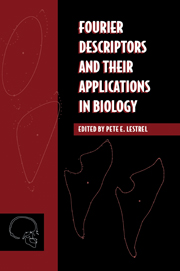Book contents
- Frontmatter
- Contents
- List of contributors
- Preface
- Acknowledgments
- Part one Theoretical considerations
- 1 Introduction
- 2 Introduction and overview of Fourier descriptors
- 3 Growth and form revisited
- 4 Methodological issues in the description of forms
- 5 Phase angles, harmonic distance, and the analysis of form
- Part two Applications of Fourier descriptors
- Appendix
- Glossary
- Index
2 - Introduction and overview of Fourier descriptors
Published online by Cambridge University Press: 14 September 2009
- Frontmatter
- Contents
- List of contributors
- Preface
- Acknowledgments
- Part one Theoretical considerations
- 1 Introduction
- 2 Introduction and overview of Fourier descriptors
- 3 Growth and form revisited
- 4 Methodological issues in the description of forms
- 5 Phase angles, harmonic distance, and the analysis of form
- Part two Applications of Fourier descriptors
- Appendix
- Glossary
- Index
Summary
Nessuna humana investigazione si pio dimandara vera scienzia s'essa non pass per le matimatiche dimonstrazione.
No human investigation can be called real science if it cannot be demonstrated mathematically.
Leonardo da Vinci (1452–1519)Introduction
Few mathematicians of the nineteenth century have had such a marked influence on both theoretical mathematics and the applied scientific realm as Jean Batiste Joseph Fourier (1768–1830). With Fourier, a distinct separation between pure and applied mathematics emerged. In terms of pure mathematics, his work led to revised formulations of the concepts of function, series, and the integral. From an applied point of view, Fourier analysis became an essential part of mathematical physics, astronomy, acoustics, optics, electrodynamics, thermodynamics, hydrodynamics, geophysics, climatology, etc. More recent applications of Fourier analytic methods include the fields of pattern recognition, biology, and medicine.
Given the continuing importance of Fourier analysis, also known as harmonic analysis or spectral analysis, it is perhaps useful to briefly define the mathematical concepts that underlie a majority of the applications in this volume.
Boundary outline models
One of the most essential and visually recognizable aspects of the biological form is its outline. Methods used to model contours are curve-fitting procedures including the conventional Fourier series (see Chapters 5–12) and the comparatively recent development, elliptical Fourier functions (Chapters 13 through 16).
- Type
- Chapter
- Information
- Fourier Descriptors and their Applications in Biology , pp. 22 - 44Publisher: Cambridge University PressPrint publication year: 1997
- 19
- Cited by



